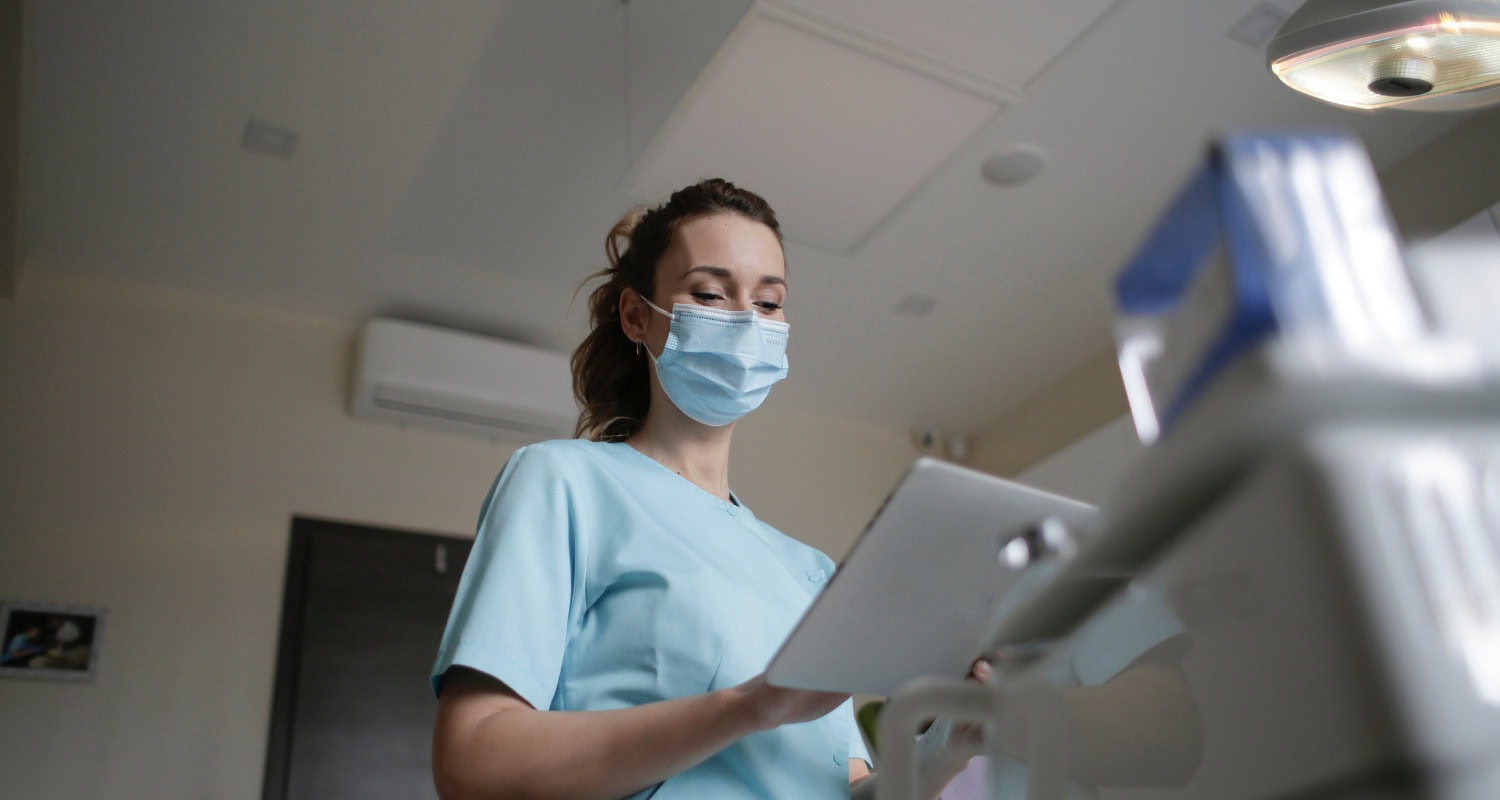Innovations in dental technology can help treat more patients, accelerate service delivery, and improve quality as numerous people face dental problems. Approximately 2.3 billion people worldwide have chronic tooth decay, while 530 million children struggle with primary tooth damage.
The surgical equipment and dental diagnostics market is projected to grow to US$ 12.05 billion by 2028. Dental clinics adopt advanced technologies like CAD/CAM, teledentistry, AI, AR/VR, 3D imaging, smart toothbrushes, and regenerative dentistry. Dentists who integrate modern solutions into their practice boost patient satisfaction, automate routine tasks, reduce manual errors in administrative work, and accelerate patient treatment.
Let’s discuss how new technology in dentistry can help dental clinics grow their business and top dental technology solutions to consider adopting.
The Main Issues Facing Modern Dental Practices and How Technology Helps Fix Them
Dental clinics can overcome many challenges using new dental technology. Dental tools help with growing patient demand, cost increase, twenty-four-hour support, and administrative tasks, among other routine dental practice management operations.
Increasing patient demand
With business growth, dental clinics need to handle more and more patients who usually require follow-up visits. Computer-Aided Design (CAD) and Computer-Aided Manufacturing (CAM) systems allow dentists to generate personalized dental restoration designs and products in one sitting. Patients won’t need to visit the clinics multiple times or use temporary dental restorations, accelerating their treatment. Another innovation that helps manage patient flow is teledentistry. Dentists can offer remote consultations and check-ups via video calls or custom surveys.
Rapidly rising costs
Dental clinics often struggle to keep up with price spikes, especially if they use cutting-edge materials or need to maintain their equipment. Robot dentistry, 3D printing, in particular, might help with rising cost issues. Due to its high precision, dentists can create turn-key bridgeworks, crowns, and other artificial substitutes. The use of 3D printers speeds up production and allows saving on materials. Additionally, the clinics won’t need to outsource denture manufacturing, which ensures fast prototyping. As a result, patients receive care in the blink of an eye, which increases retention rates and maintains the clinic’s stable income.
Need for round-the-clock support and booking services
Patients require instant support, and emergency coverage is also required by national appointment and availability standards. That is why dental clinics rely on AI customer support bots. Such chatbots are available at any time, providing necessary information to patients. Usually, chatbots can operate using a custom database supplied by a specific dental clinic. Some AI assistants can help with visit booking and rescheduling and don’t require human engagement.
Overload of administrative tasks
Along with patient management, the administrative office must handle billing and insurance claims. To help them cope with the tasks, dental clinics can use automated billing tools that generate invoices, check claim validity, and send patient payment follow-ups. Some billing systems provide different payment options to patients, which ensures flexibility. For example, automated billing and text-to-pay functionalities allow patients to pay via smartphones, which reduces missed payments and takes the weight off front desk staff.
Top 7 New Dental Technology Solutions
What technology is leading the field? Let’s discuss promising technological advancements that can enhance services in dental clinics. If you run a dental business, consider adopting them to improve diagnostics, treatment accuracy, and the quality of services.
1. Digital Dentistry and CAD/CAM Technologies
Digital dentistry maximizes the efficiency of dentist visits and enables the instant creation of prostheses. Using intra-oral scanners and technology like CEREC, you can get artificial teeth without many try-ons, multiple visits, and weeks of waiting.
Computer-aided design and computer-aided manufacturing (CAD and CAM) are the most significant digital advancements in new dental technology. Digital dental software development services enable the creation of custom orthodontic devices, 3D modeling, and 3D scanning. The tooth form is reproduced precisely, and the implant looks quite natural. These tools also optimize manufacturing and may save time and human resources in creating prostheses, devices, and details.
The design and manufacturing technologies integrate into in-office and laboratory systems. Enabling the new precision of restorative dental structures, CAD and CAM represent the future of prostheses and orthodontics. And it’s not about 3D anymore; it’s 4D printing as of today.
2. Teledentistry in Patient Monitoring and Check-Ups
Constant communication with doctors and the ability to send photos or videos of the problem give patients a sense of care and protection, while clinics have more trust and well-deserved recommendations.
Suppose a patient notices a piece of her dental filling broke off while eating and starts to experience sharp pain when teeth come into contact with cold liquids and even during sleep. The dental professional is overbooked for offline visits, and the administration recommends the patient complete a website form describing the issues and wait for a visit. When a dentist has a free minute between patients, they review the details, identify the problem, and refer the patient to an endodontist for root canal treatment. As a result, the patient can receive dental care the same day and doesn’t need to wait for the dentist’s availability while suffering from pain.
Society also responds to the innovation dentistry is implementing at the legislative level. In January 2020, the law came into force in California to protect the patients’ rights in teledentistry practice. The American Dental Association also has a specific policy on teledentistry.
Read more about: Telehealth Implementation Process
3. AI in Dental Diagnostics
Integrating AI tools in daily dental practices reduces the chance of misdiagnoses and facilitates disease detection. In 2022, researchers explored the use of AI in dental disease diagnostics, focusing on convolutional neural networks (CNNs) to detect cavities within intraoral images. The results proved the AI’s potential for identifying cavities, though some improvements were still needed.
Another study on AI dental technology reviewed how AI could help diagnose various oral conditions, such as sinus infections, caries, oral cancer, gum diseases, and TMJ disorders, using diagnostic images. The researchers found that new dentistry technology powered by AI could improve diagnostics accuracy and cut costs. The study also assessed AI software designed to analyze panoramic X-rays. The software accurately identified dental structures like dental implants, dental fillings, crowns, and root fragments.
Robotics in dentistry with AI can also effectively diagnose maxillary sinusitis. Using panoramic X-rays, researchers compared the performance of a deep learning (DL) model to the efficiency of two radiologists and two dental residents. The AI performed at the same level of efficiency as radiologists and outperformed residents. It achieved 100% accuracy in identifying normal and inflamed sinuses and high sensitivity in detecting mucosal retention cysts.
4. AR and VR in Surgery
Augmented reality (AR) provides real-time visualization during dental procedures. AR systems put digital images over a patient’s physiological structures, improving the accuracy of the surgery. For example, AR navigation tools assist in dental implant placement, providing precise angles and locations, which reduces mistakes and enhances the results of dental treatments.
Combined with virtual reality (VR), these technologies transform how dentists plan and perform surgeries. With VR, dentists receive a detailed, 3D view of the surgical area, allowing them to plan each step before the surgery. AR and VR also improve communication with patients. Using interactive images, dentists can explain the process of complex surgeries more clearly. This can reassure the patient that the dentists thought out the surgery to the smallest detail. In addition, AR plays a valuable role in planning anesthesia injections. The dentists know the exact location for anesthesia, which reduces patient discomfort and improves procedure efficiency.
5. Dental Imaging Technologies
The recent technological innovations in dental imaging are CBCT, intraoral scanners, and digital dental radiographs. Cone Beam Computed Tomography (CBCT) uses an X-ray beam shaped as a cone to scan the patient and capture images multiple times for better precision. It generates a detailed picture of a patient’s bone to detect the issues with sinuses, jaw, and teeth. This technology ensures reduced exposure to radiation in comparison to traditional CT scanners. A dental laboratory can use this tool for orthodontics, surgical planning, joint disorder diagnosis, and identification of jaw tumors.
Intraoral scanners take multiple images of the patient’s anatomical structures. These scanners are usually small and can fit into a patient’s mouth, enhancing accuracy and diagnostics comfort. The tool helps generate precise 3D images, which provide better visualization of a patient’s teeth, jaws, and other physiological peculiarities. The procedure doesn’t take long and can easily fit into the lab. Moreover, intraoral scanners simplify hygiene maintenance required to generate digital impressions. Dentists don’t need to check numerous appliances and materials since they can replace them with a single intraoral scanner.
Digital dental radiographs offer several advantages over traditional X-rays. They can detect issues in hard-to-reach areas like decay between teeth or tumors that simple dental examination cannot detect. Such tools provide instant results and don’t lose quality if dentists share the images electronically. Digital radiography allows for minimized radiation exposure and is more environmentally friendly. Dentists can easily add dental images to patient medical records, facilitating insurance claim processing and speeding up treatment.
6. Smart Toothbrush
Attention to oral care and dental health has caused a cascade of innovations in the field over the last decades. Today, no one will be surprised with an electric toothbrush, and the technology is moving forward. The smart brush aims to teach people to brush their teeth correctly and prevent oral diseases. It’s equipped with sensors that record your movements and the time spent, analyze them, and send the information to an app on your smartphone. It’s an engaging and effective prevention technology that helps establish oral hygiene habits. An attractive look and an organized promotion turn smart toothbrushes into the desired product.
7. Regenerative Dentistry
Regenerative endodontics is used to restore pulp function and regenerate the pulp-dentin complex in teeth with severe inflammation or necrosis. Dentists usually treat these issues using pulp revascularization, which boosts root development in inflamed teeth. They stimulate bleeding to create a blood clot that supports the growth of stem cells necessary for healing. This treatment promotes tissue regeneration and strengthens dentinal walls.
Another new dental technology that can help with dental regeneration is 3D bioprinting. Robotic dentistry with 3D bioprinting relies on computer-aided design (CAD) for more precision. This process involves accurately placing biomaterials and cells in specific patterns to create tissue-like structures. Dentists can control how cells and materials are arranged for better cell growth and tissue regeneration.
The Future of Dental Care: Trends and Startups
When asked about what technologies can impact the dental industry in the future, most dentists believe in the potential of AI (31%) and restorative materials (33%). Fewer specialists mention 3D printing (28%) and 3D imaging (8%). Even though these technologies have been gaining popularity for some time, now they have become an indispensable part of dental services.
As for the financial part and the impact of the newest dental technology on ROI, dentists have confidence in digital intraoral X-ray systems, curing light, intraoral cameras, and practice management software.
Industry Innovators to Follow
The future of dentistry will revolve around preventive medicine to enhance patient dental care. Dentists will track inflammatory markers and biomarkers to get a bigger picture of a patient’s oral health. For example, monitoring saliva microbiome to detect inflammation. Some startups refine the use of AI and 3D imaging technologies, boosting the progress of dentistry.
Floe Oral Care
Floe Oral Care is a British startup that provides oral health management technologies powered by AI. Their tool performs salivary diagnostics to monitor dental indicators. This allows dentists to apply a preventative approach using non-invasive methods. The startup focuses on painless dental health care, encouraging patients to look after their well-being.
Relu
Another startup, Relu, develops AI-based software that transforms 3D medical images into different file formats. The tool helps monitor mandibular canals and panoramic arches to improve their visibility. Their treatment techniques also help to find the proper position for implantation and implant size based on the individual characteristics of each patient. Moreover, digital impressions and facial scans can be easily aligned with the CBCT scans.
EM2AI
EM2AI is a startup based in Singapore that offers AI-based solutions for dental diagnostics. Their technology analyzes X-rays using smart algorithms that ensure accurate issue detection. Also, the company provides EM2Clinic cloud platform for practice management purposes. It includes patient billing, medical records, scheduling, and diagnostic tools in a single system that simplifies treatment workflow.
AI Smile
AI SMILE, a project of Weiyun AI & Robotics Group, creates intraoral scanners that help with restorative dentistry, orthodontics, and implantation. Their solution offers quick 3D model and treatment simulation development to inform patients about necessary dental procedures in real time. AI SMILE provides 10mm scanning precision and high-definition images due to its ability to generate 30 frames per second. The solution has a balanced center to ensure comfort for dentists holding the scanner during procedures.
Why You Need Custom Software Development to Implement Dental Technology Innovations
Software development professionals can help dental clinics implement technological advancements and adopt innovations. All the new technologies mentioned above require quality software integration to be used efficiently. Here’s why you need software development services for dental technology:
- Modern device integration
Software developers can help you connect new devices to your system and configure them to work in tune with other dental equipment, ensuring interoperability. - Teledentistry implementation
Custom software development is essential to integrate telehealth solutions for online consulting, remote patient monitoring, and follow-up texts. - Workflow automation
Since each dental practice has unique needs and different administrative processes, software developers create custom solutions that can be easily integrated into existing systems. Such software can generate invoices, track payment processing, notify dentists about pending payments, and automate many other tasks. - Ensuring data security
Software developers ensure dental systems comply with HIPAA and GDPR and protect patients’ health data privacy. Also, they implement data encryption features and means to manage unauthorized access. - Software customization
Dental clinics may require specific functionality that isn’t available in off-the-shelf solutions. Custom software development ensures smooth integration of turn-key features that don’t impede overall software performance.
Custom software development provides clinics with modern systems that ensure fast work and enhance patient service. Such software also enables better patient outcomes due to the possibility of remote consultations, online booking in urgent cases, and more accurate diagnostics.
Empeek for Dental Software Development
Empeek is a custom healthcare software development company that can build custom dental solutions for businesses that have unique workflow. We use flexible cooperation models to meet your project requirements, including software creation from scratch with a dedicated team or providing engineers for specific tasks. We follow HIPAA and GDPR regulations during software development and integrate additional security features to protect PHI.
Looking for custom software development services for your practice? Contact us for consulting and engineering help.
Conclusion
With innovative technologies, dental clinics can maintain customer flow, automate administrative tasks, and provide patient dental visits remotely without overloading the staff. For example, in-house 3D printing allows dentists to quickly create quality implants or bridges so patients don’t need to postpone procedures. The same goes for urgent care when the dentist isn’t available in the office but can review the problem online and instruct assistants on further actions.
When choosing a software development company, pay attention to relevant industry experience and the ability to build software end-to-end. Empeek’s team can develop custom dental software from scratch, assist you with specific tech tasks, or provide consulting. Contact us to discuss your project and get professional engineering advice.







